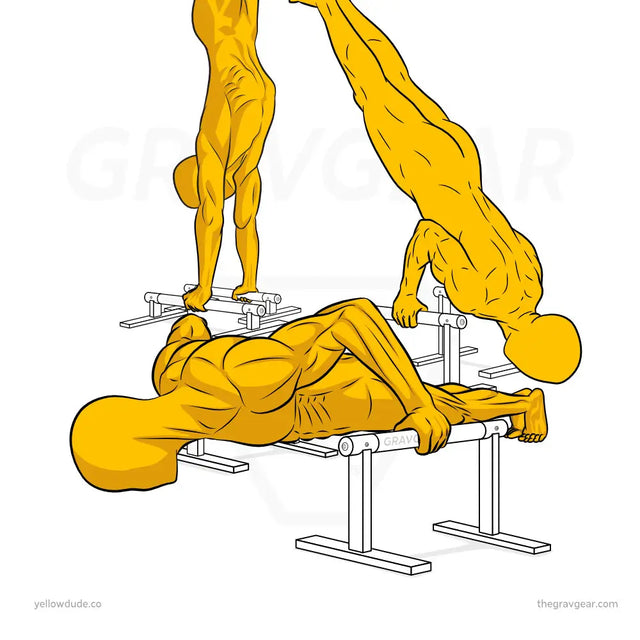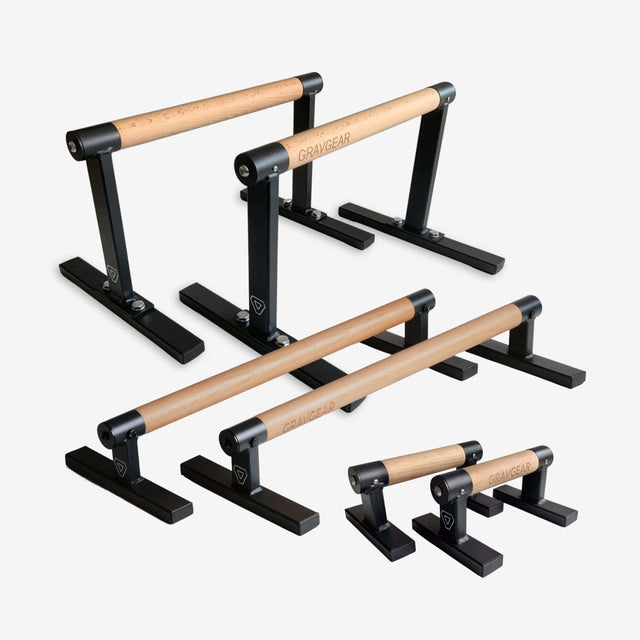9 calisthenics shoulder exercises using wooden parallettes
With so many shoulder exercises to choose from in calisthenics, which one is for you? I've got a few in mind, with the help of wooden parallettes. These calisthenics shoulder exercises should make sure you trigger hypertrophy by challenging you properly...
Calisthenics uses what we call “compound exercises”. These are just moves that use groups of muscles.
So we're not ONLY targeting shoulders here. But choosing exercises have the most bias towards the lateral, posterior, and anterior delts that make up your shoulders. (as well as the scapula)
Training shoulders with maximum intensity is what's going to get you that ripped, aesthetic look. Which I'll be covering right here as we continue...
So why even use parallette workout variations?
You can do your workouts both with parallettes and without.
Non-parallette exercises give you great wrist strength and conditioning. Just as parallette variations help you hit the muscle group you're targeting. While not being limited by your wrist mobility or strength.
I've seen a lot of people talk about how they love the increased range of motion they get, especially from tall parallettes. Which is key to maximising muscle time under tension.
Okay, well how do you implement parallettes in your calisthenics training?
I find parallettes particularly useful as supersets. Or during hard static holds like handstands and planche training.
For example, after about three and a half holds of wall-assisted handstands, your wrists might start to ache…
You’d probably destabilise from fatigue and injure yourself if you kept doing them. As your wrists are under a lot of constant pressure from your whole bodyweight.
It's always good to train every part of your body. But I can't imagine the damage you could do to yourself if you toppled the wrong way (not to mention if you had a weight vest).
So after a good solid two or three handstand holds, it's probably best to use parallettes for any more sets you'd do after that.
In summary, use them a bit like wrist wraps. But don't forget the extended range of motion benefits.
Here are 3 bodyweight shoulder exercises for beginners
1 - Standing pike isometric press
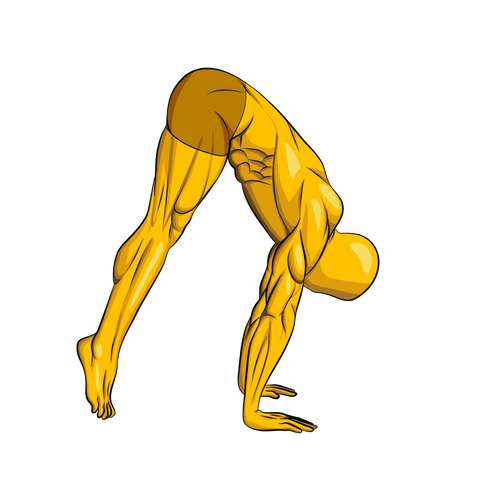
Hold this Pike position and press down as hard as you can with your shoulders.
Make sure to control your breathing and maintain tension. It's a very uncomfortable move at first. But it's very important to get you moving towards the handstand in terms of both strength and how the move works.
Mini parallettes or long parallettes would help you lean further into this move for more shoulder stimulation - after your wrists ache a little too much from doing them on the floor.
2 - Scapula push ups

As part of the entire shoulder function, the scapula is a very important part. It’s a bone that engages with 6 types of movement of the shoulder joint.
So training this can really help you with skills down the line, like the handstand. As it gives you mobility and strength benefits in the scapula region.
With these, you’re not looking to get any range of motion benefits from parallettes, but good ol’ wrist support. As you probably need more reps to stimulate this area. I’d go for mini or long parallettes here.
3 - Planche leans
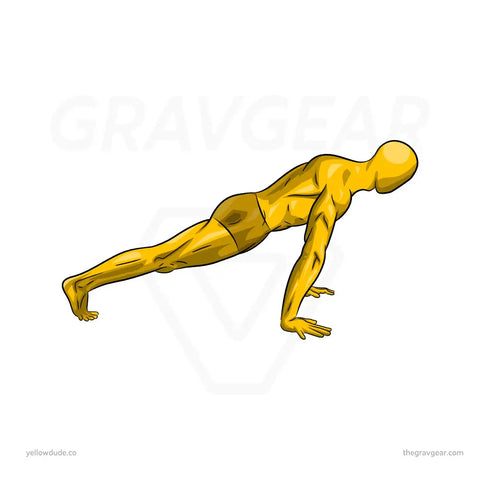
You gotta love the planche lean with its great stability benefits, and massive challenge on the lateral delts.
It’s harder than it looks. With the right form, you might find the first things to droop are actually your trapezius and or rhomboids.
Just like any move, the more you practise it, the faster you'll progress to the next move. If this is a little bit too hard for you as a beginner, you can always just put your knees on the floor. Do the same form, and lean forward as far as you can maintain.
Long parallettes will help you the most here. As the deeper into the move you go the more wrist flexibility you'll need.
Have a mix of holding the form with your hands rotated, so your thumbs point forward. And using parallettes in supersets, or half of your total sets.
And here’s 3 intermediate calisthenics shoulder exercises (PLUS 1 powerful bonus move)
1 - Tuck planches

The difficulty of any planche movement is amplified the more you lean forward.
If you're doing these right you'll learn a lot more control and you'll gain more mobility in your wrists and shoulders.
And since you're supporting your entire body weight, you'll get a really strong burn too, which will help develop your shoulder muscles.
Knowing all this, we can immediately understand how your wrists will be put under a lot of pressure. So I will do half of my sets without tall parallettes, and half with tall parallettes.
2 - Pike push ups
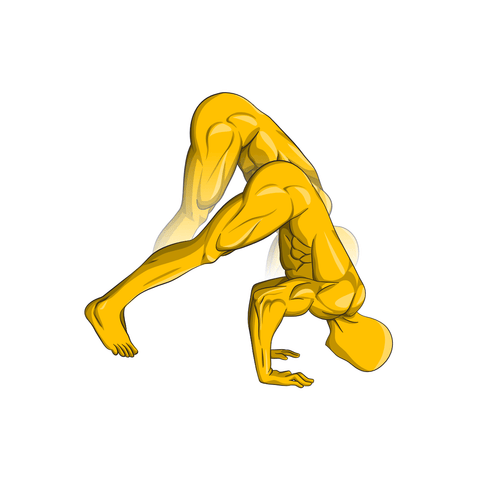
The more you elevate your legs, the harder this gets.
For powerful moves like these, I would even dedicate a whole workout session to just doing them. So I could really max out the hypertrophy and get some juicy shoulder gains.
I’ve done workouts like this before and seen massive muscle growth:
- Start at hardest variation you can do
- Crank out as much reps as you can
- Move down to the second-hardest variation
- Do reps until failure
- Repeat until you’re doing the easiest variation, e.g. knee pike push ups, and your shoulders have given out!
That’s a routine I like to call the “GRAVGEAR HYPER SET”, which is inspired by Mike Mentzer’s training methods.
Mastering these will not only develop the two front heads of your shoulders. But also set you up for getting ever so closer to the universally respected handstand push up.
The best parallettes for pike push ups are clearly the tall parallettes. As they give you that extended range of motion.
3 - Chest to wall handstand holds

These are fantastic for all the isometric exercise benefits you get in the shoulders.
I like to include this because it's really effective for shoulder stimulation. But it also helps you progress towards a handstand. Win-win if you ask me.
You could honestly do all of these sets using parallettes, as all your bodyweight is on your wrists. Leaving that choice open though, mix around what you use based on your own judgement.
BONUS - Wall posterior delts isolation exercise
With all these awesome moves we still leave the posterior deltoids hanging (in terms of stimulation). Which is unideal if you want a balanced physique.
Daniel Vadnal brought this one to my attention, so I’ll let him explain this move in his rear delts bodyweight exercise video.
Of course, we got 3 calisthenics shoulder exercises for the real advanced people out there
1 - Handstand push ups
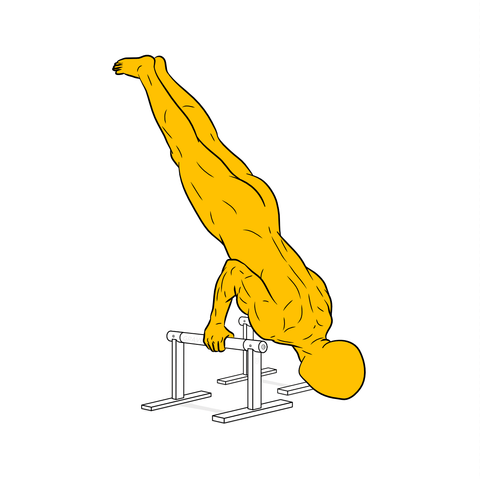
Massive coordination, stability, and strength is required to do this. But that’s the point. As you get massive coordination, stability, and strength GAINS by doing it.
When you get to advanced moves like the handstand push up, your shoulder development will really blow up. Tall parallettes will come in very handy, especially with their increased range of motion.
I’d judge how my wrists are feeling after each set, and add in tall or long parallettes when needed.
2 - Pseudo planche push ups
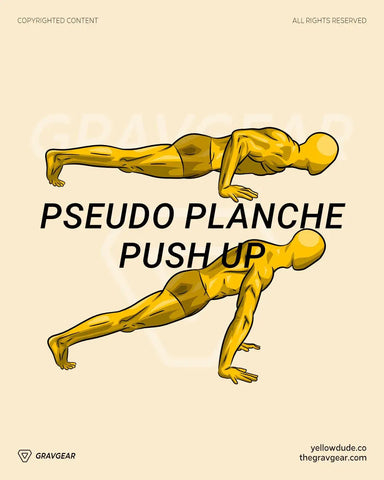
Pseudo planche push ups are probably best done with tall parallettes, and with no parallettes. Primarily shoulder and wrist gains are acquired here.
You may argue these involve the chest a lot, which is true. But as I said before, with planche exercises, the more you lean, the more your muscles scream!
Anyway, long parallettes provide the most stability. Which helps you keep strict form with these throughout the whole ROM.
3 - Planche holds
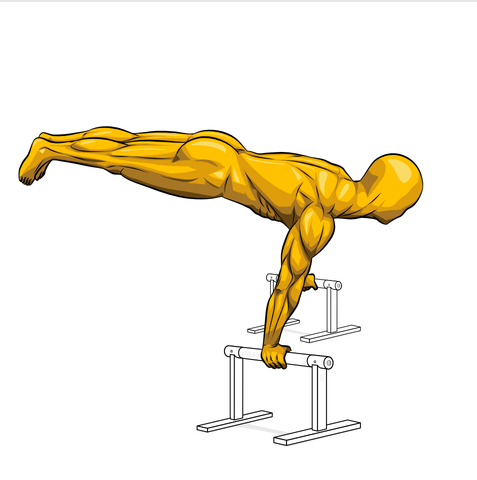
Of course, the planche will give you shoulder gains any day.
We are using a lot more muscles, of course (core, legs, chest, pretty much everything ngl). But the pivot point is controlled by your shoulders. Meaning a helluva burn when you use the right form.
Weave in parallettes where you like. At that level of experience, you’d know exactly when to use them based on the feeling in your wrists.
You might do all sets using them, or no sets. Up to you.
It just means more flexibility is required without parallettes. And the grip is less comfortable, which can be your weakest link in an intense workout.
Alright, so why are wooden parallettes even worth it?
I would say the key deciders that make them worth it or not are how much you'd use them. And what your goals are.
If you're training a lot of skills like planches and L sits, they are certainly very useful. Especially long term when you are adding weight to all your routines.
Wooden ones can be especially worth it solely for their grip.
As someone we know called Seb said in a review video:
“To be honest, it does feel a bit smooth when you glide your hand across. But somehow when you start gripping it actually has quite a bit of friction.”
Another guy said on Reddit:
“I've reached that stage in my training where my wrists become extremely painful when I train tuck planche or practice handstand variations. I know developing wrist strength takes time with specific stretches/movements, but I want an alternative that I can use now. Also, with parallettes there's more elevation thereby making it easier to practice L-sit to Handstand.”
A reviewer of parallettes also pointed out:
“I struggled with grip on the steel parallettes at the gym, which made starting calisthenics additionally stressful.”
Well, we’ve heard what others have to say. Let’s have a look at the general pros and cons of wooden parallettes to get a good feel for where they fit in the picture.
Fair, but what are the pros and cons of wooden parallettes?
Awesome advantages of wooden parallettes
- Wooden parallette bars age better than plastic ones, which can break, and they're overall a better choice than metal. Which can be slippery and heavier than needed.
- Some have birchwood handles giving an ergonomic smooth yet grippy finish. (especially handy with heavier loads)
- In general, parallettes give you more control. Rather than relying on your fingers for moves like the handstand. Where you balance yourself when falling back (heel of the hand pressure) than forward (finger pressure).
- They also have another bonus of not requiring you to use grip chalk.
- They're not specifically designed for rehabilitation, but the natural wrist joint positioning may reduce pain. And even support strengthening injured or problematic wrists.
- Better hand health by using wood and not plastic.
- Light and easy to carry. Workout anywhere anytime.
- Slight sweat absorption which helps maintain strong grip when you bring the heat in your workout.
Potential concerns with wooden parallettes
- When you're doing intense workouts and you grip the parallettes really hard, your hands can hurt at the end. A good tip to avoid this is to not grip 100% all the time. But instead have moments throughout your reps where you don't grip AS hard.
- Some people forget about taking care of their wrists the minute they realise they can use parallettes and wrist wraps and no longer feel wrist pain. You always want to include some kind of warm up or call down for your wrists. Eventually, you'll be able to get your hands on the floor pain-free. Just remember that connective tissue can take more than 200 days to adapt to your training.
- After some time of using parallettes, you'll probably understand that there are more elements at play than you realise. Your wrists aren’t your only weakest link. Sometimes you can experience finger joint pain, and the simple fix for this is just being more aware of how you exit skills like handstands.
- Over-relying on parallettes, for moves like the handstand, can hurt your carry over. This is where you are great with parallettes but aren’t so good flat on the ground. You always want to incorporate flat on the ground training and parallette assisted work too.
- When you're kicking up into the handstand, it's harder with the elevation of tall parallettes. But you'll realise this is actually good news in the long run, as it will help you develop more awareness of the movement.
Hmm, how tall should parallettes be based on my goals though?
What kind of height you'd want depends on what moves you train. And such what skill goals you’re working towards.
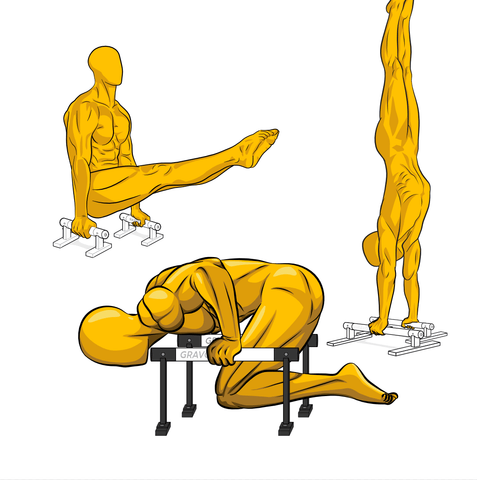
Tall parallettes
Since these give you the most elevation from the ground, they are the best for practising transition moves like the L-sit to handstand.
Confidence in your form will go through the roof as the stability, comfortable grip, and aesthetic look help you get super clean reps and satisfying workouts.
The increased range of motion tall parallettes give you makes all the difference to your set’s time under tension.
Overall, tall parallettes are best if you have a varied workout routine with many calisthenics skills.
Long parallettes
If you want to progress to more advanced moves, like the handstand push up. Then the stability this gives you helps you learn to balance your lower body a lot faster.
For handstands, they’re a game-changer. With most beginners that use long parallettes saying they learned it very quickly.
These are especially useful if you have a wider frame with broader reach. As the handles are the longest so you can customise your hand positioning more.
Stability benefits are highly underrated. Go try them out for yourself and you'll notice the difference.
Mini parallettes
The smallest and lightest, making it ideal for people who are always on the move. Or looking to save space.
Doing a travel parallette workout is always fun, but they are just as good for people with home gyms.
Anyone who’d like extra support for push ups, L-sits, and the planche progressions would find a lot of use out of these.
I’m wondering, how long should a calisthenics workout even be?
For muscle growth, the only thing that matters is intensity and time under tension.
An effective way to measure time under tension is tempo. As shown in the image below.
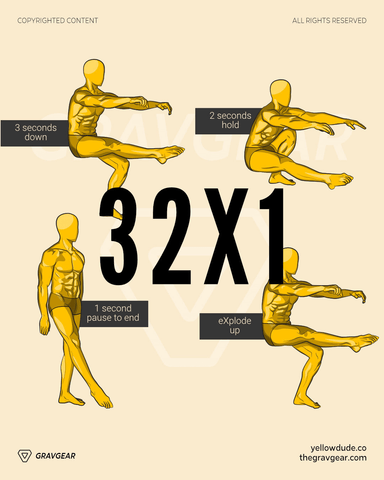
You count each second through your rep range, and each rep is worth so many seconds.
Tally that up after a few reps and you got yourself time under tension per set.
With intensity, it's about how hard you imagine yourself pushing, and how hard you actually push.

You want to imagine yourself heavier than you actually are, as if you had a thousand kilograms weighing you down. Also picture your muscles being on fire and working really hard.
These two elements not only help you stimulate your muscles more, but also faster. And they apply to any exercise.
In terms of the length of a workout, that varies a bit depending on your goals...
Want more tone and muscle tissue density?
Then you wanna blast out lots of reps at a lower exercise difficulty for longer. Like doing two hundred knee push ups in a row really fast.
This would mean your workout might take ten to twenty minutes.
The intensity and time under tension is there. But this way of doing things leads to more endurance/tone benefits.
Want lots of muscle mass?
With this, you’d want to do five sets per muscle.
Have forty to eighty seconds of tension total per set.
The number of reps you do depends on the tempo you choose, I usually go zero-four-two-one tempo for eight to twelve reps.
This means you’d have around fifteen to thirty-five minutes working out using this approach.
Muscle mass is gained the most during rest, so you want minimum forty-eight hours rest before doing five sets of the exact same exercise.
The more you can spread out your routine the better.
Want another option?
If you're confused about this or couldn't find what you were looking for, send us a message in our telegram channel, or email us.
How many times a week should you do calisthenics workouts?
We have many options to arrange our workout routines. It's usually based on how much time you have, or how much time you want to spend.
Some like to train every day, but only one exercise (to save time). And they spread out their routine. Like this:
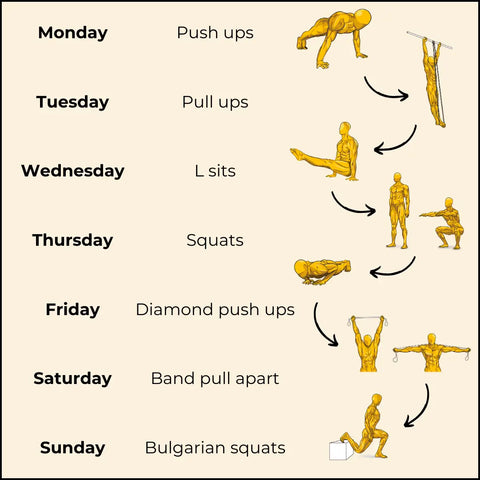
In this example, by the time he gets to Monday again, he's basically recovered his chest from push-ups.
Now, you have that option above. But you could also only train Monday, Wednesday and Friday. Then pack more exercises together in a single session.
E.g. Monday you do push ups, dips, crunches, and planks. (PUSH + Abs)
The number of times you train a callisthenics workout per week really depends on your preferences at the end of the day.
Ask in our Gravgear telegram channel if you have some specific questions about this.
Great, so what now?
You should now have a great understanding of how to use wooden parallettes in your workout routine. And how to target shoulders more effectively using callisthenics exercises.
If you're looking to buy parallettes, then you've likely seen our range of wooden parallettes for sale.
We have over fifty reviews that speak for themselves. This should help you decide whether they're for you or not.
Go out and crush your training!

